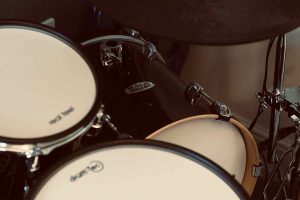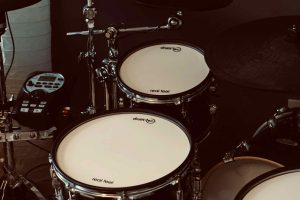Drums are great fun, but playing at a loud volume for extended periods of time runs the risk of permanently damaging your hearing. Seasoned drummers, musicians and people working in the music industry will attest to the importance of hearing protection for both performance and longevity in the field. Below, we’ll dive into the key reasons why drummers should consider hearing protection and provide actionable strategies to do so.
Why You Should Wear Ear Protection When Drumming
If you play an acoustic drum kit, hearing protection is essential. Having played drums for over 20 years, I’m grateful to have used ear protection from an early age. Unfortunately, friends I have played with for many years have not been so lucky and suffered hearing damage, largely because they chose not to wear ear plugs for many years.
Permanent Hearing Damage is Real
Extended exposure to loud noises can lead to tinnitus (a persistent ringing in the ears) or even permanent hearing loss. Drumming, with its powerful percussive sounds, can easily produce sound levels that exceed safe thresholds – even in as little as 30 minutes of exposure.
At first, these tinnitus effects might only last a few hours or until the following morning. But after repeated exposure, for example after years of drumming without hearing protection, tinnitus can become permanent. There’s a reason why you’ll see bar staff at gig venues wearing ear plugs, so as a drummer, it’s well worth investing in a good pair yourself!
Better Focus on Dynamics
Ear protection can actually help drummers pay better attention to their dynamics, allowing them to discern soft passages from louder ones, improving their overall musicality.
Expressive drummers incorporate dynamics into their playing. Softer passages help add emphasis to louder parts, while individual grooves can incorporate dynamics such as ghost notes for greater feel.
Better Sound Quality
Some ear plugs can actually help improve how your drums sound to you, similar to an EQ on a stereo. Having worn a range of different ear plugs when playing my acoustic drums, typically I find they make cymbals sound less “harsh” and generally a nicher sound when using bright cymbals such as the Zildjian A Custom or Istanbul Agop Xist ranges.
Similarly, against a quieter backdrop, bassy sounds feel more intense, since you’ll still feel the vibrations of a loud bass drum or bass guitar speaker, but at a lower volume level.
How to Find Affordable Ear Plugs
You don’t need to spend a lot of money for effective hearing protection. Here’s three types of hearing protection to consider:
Foam Ear Plugs
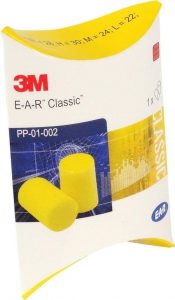
Disposable foam ear plugs are the cheapest route to hearing protection, typically offering around 32dB of noise reduction.
The downside of course is that you’ll have to continually buy new pairs of plugs, and since they’re disposable, they’re not great for the environment. Foam ear plugs are therefore best as an emergency back up.
Reusable In-ear Plugs
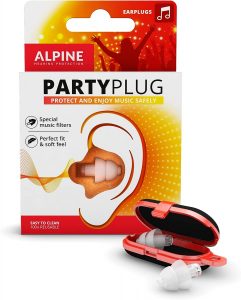
For a more long-lasting and high quality solution, consider buying a set of in-ear plugs designed for music. These reusable plugs typically cost between $13 and $45, and offer varying levels of sound isolation. On top of that, many ear plugs like this are specially designed for concerts or other musical settings. As a result, they help to filter the sound, similar to an EQ on a mixer.
Personally, I use Alpine PartyPlug ear plugs. To me, they make my drums and cymbals sound more defined, and offer a good amount of sound attenuation (19dB), meaning I never get ringing ears after practice sessions, even when playing for up to 3 hours. Plus, they also come with a useful carry case that can be snapped onto a keyring, so you’ll always have them to hand.
Ear Defenders/Ear Muffs
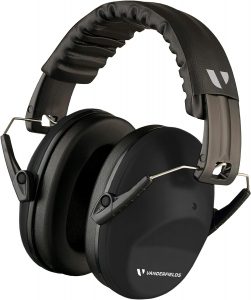
Finally, some drummers like to use over-ear ear defenders. These offer great levels of sound isolation, at the expense of added weight and bulk. Ear defenders are the best hearing protection for younger children, as ear plugs are generally not recommended due to the high chance of pushing ear wax into the ear lobe of smaller ears.
Keep the Volume Down in the Rehearsal Studio
Of course, investing in a set of ear plugs is not the only way to protect your hearing. When you’re not performing live, there are benefits to playing more quietly and taking regular breaks. Below, we look at why it’s worth dialling down the volume when you can.
Be Volume Conscious
Just because you can play loudly doesn’t mean you should, especially during extended rehearsal sessions. Use volume as a tool, not a default setting.
Playing at a lower volume in the rehearsal studio could actually help your band play better together. At a lower volume, it’s easier to hear your bandmates with more clarity, helping you to perfect your timing and hear any mistakes, enabling you to work on them instead of carrying them through to your live shows.
On top of that, lower volumes ensure your singer is heard and not straining their voice. There’s nothing worse than your singer experiencing vocal cord strain before a performance!
Take Regular Breaks
Giving your ears regular breaks during intensive practice sessions can help prevent hearing fatigue and reduce the risk of damage. Even if you’re using ear protection, sustained loud volumes can still cause hearing damage. Of course, taking a break is good for other reasons, helping you to reduce mistakes caused by fatigue.
Using Drum and Cymbal Mutes or Practice Pads
If you’re playing the drums alone, there’s no real need to be playing at full volume. Of course, you could soundproof your drum room or apartment to help reduce volume for others, but reducing the volume of your drums is the first step to protecting your hearing and that of others.
Reduce Volume, Not Skill
Drum and cymbal mutes are fantastic tools that can drastically reduce the volume of your acoustic drums. These mutes are placed directly on the drumheads and cymbals, dampening the sound without compromising the feel significantly.
Most drum mutes are foam pads that fit over your drums or cymbals, significantly reducing volume and changing tone to a gentle “thud”.
Of course, there will be some effect on feel, but it could actually be good for your drumming. The foam pads will slightly reduce the rebound of your drums, meaning you have to work a little harder to perfect drum rolls and grooves.
However, this helps to build strength, so over time when you take the mutes off, you’ll have more arm strength to play rolls quickly and accurately.
Ideal for Late Night Sessions
For drummers who like to play late at night or live in shared spaces, mutes can be a saving grace. While they won’t allow for completely silent drumming, they significantly reduce volume and may allow you to play at more unsocial hours compared to an unmuted acoustic kit.
However, be aware of impact noise, which is caused by the impact of your bass drum beater and hi-hat foot, causing vibrations to travel through floors and walls. We take a deeper dive into impact noise and how to reduce it in our guide to making your own DIY Roland Noise Eaters.
Use a Practice Pad
Another low-volume alternative to using an acoustic kit is to switch to a practice pad. Practice pads have a rubber surface and are significantly quieter than an acoustic kit. If you’re practising drum rudiments, then there’s also no need to use a full acoustic kit – a single drum or pad will do.
For me, it’s much easier to use a pad for perfecting my rudiments, as I find a full kit distracting. If you’re like me and you find yourself drifting off and playing something you know on the full kit instead of sticking at your rudiments, then a practice pad could be a great way to develop your chops while protecting your hearing!
Consider Using Electronic Drums for Practice at Home
Finally, if you have an acoustic kit at home but want to play for longer hours without damaging your hearing, then an electronic drum kit might be the way to go. eDrums have come a long way in recent years, including a wide range of eDrums that look like acoustic drums. Below, we look at some of the key benefits of going electric.
Volume Control
One of the greatest benefits of electronic drum kits is the ability to control volume. You can plug in headphones and play without disturbing others, and you can easily adjust the volume to a comfortable level. As we’ve already noted, this means you can play for longer without hearing damage. Ideal for lengthy sessions!
Variety of Sounds
Electronic kits often come with a range of drum sounds, allowing you to experiment and find great tones. One of the reasons many drummers dislike practice pads or drum mutes is the fact they don’t sound like real drums. Electronic drums add these drum sounds back in for a far more immersive experience.
Even if you have a cheap electronic kit, you can make your eDrums sound real using a computer, a USB cable, and VST drum software like EZdrummer 3.
Don’t Let Drumming Ruin Your Hearing!
In conclusion, my years as a drummer have taught me that our hearing is one of our most precious assets. It’s not just about preventing hearing loss, it’s about ensuring that we can continue to enjoy the beautiful intricacies of music for our entire lives. Whether you’re a seasoned professional or just picking up the sticks for the first time, make hearing protection a priority. Your future self will thank you!
Featured image by Josh Sorenson
This article contains affiliate links. If you purchase a product through certain links on our site, we may earn a small affiliate commission. Learn more about our adverts and why you can trust eDrumHub here.

